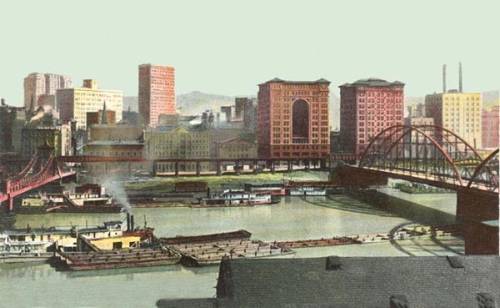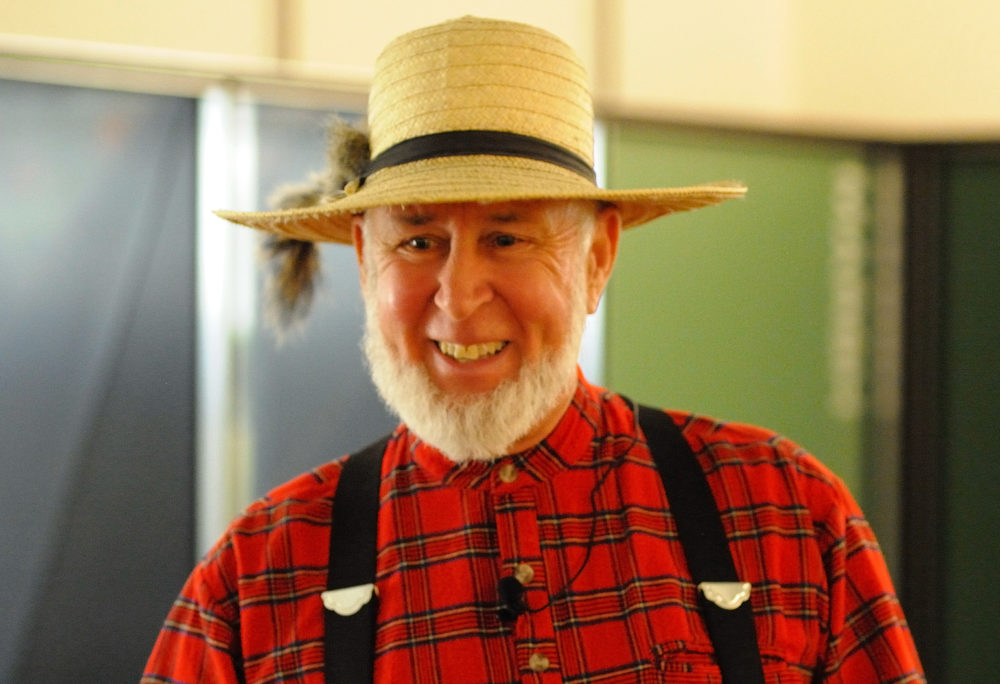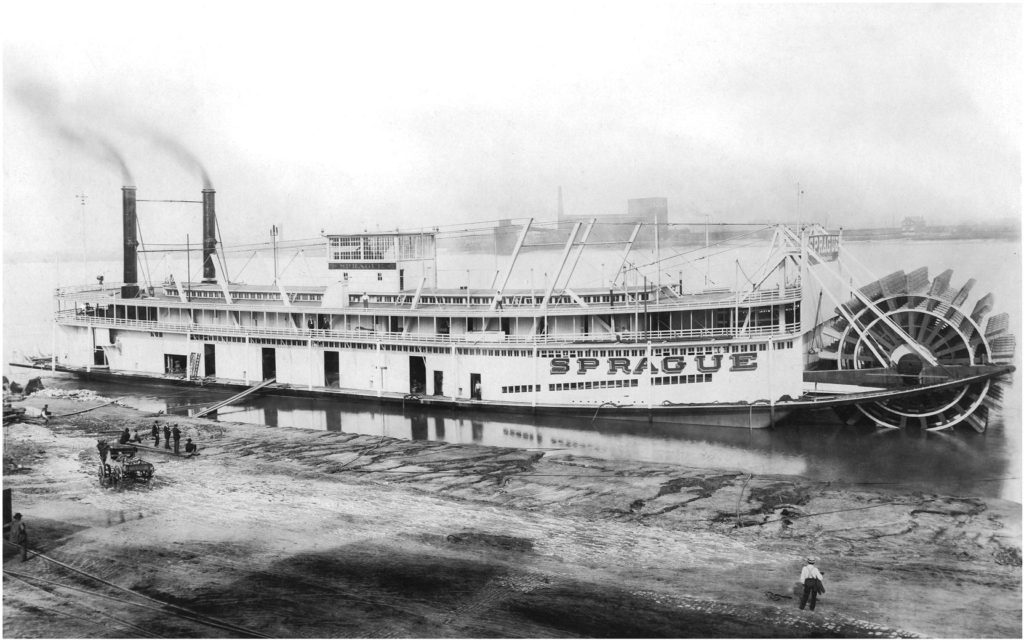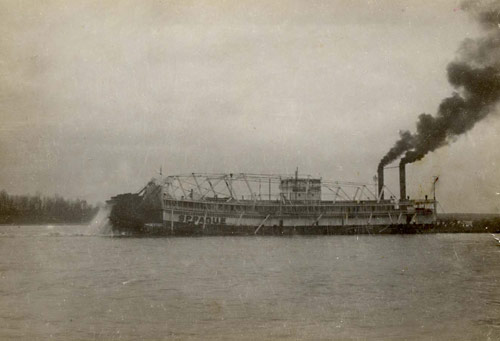
It was November 1758 when a British army, under the command of General John Forbes, advanced upon the French Fort Duquesne from the east. After a short battle on Grant’s Hill, the French force departed down the Ohio River, leaving their fort a smoldering ruin. General Forbes would give the name of Prime Minister William Pitt to the site, soon to be Fort Pitt, and later the village, town, then city of Pittsburgh.
It was the summer of 1958 when Pittsburgh hosted events to celebrate its bicentennial. Its two-hundredth birthday – two centuries old! I was a fourteen year old boy in the summer of 1958. I recall a few of the bicentennial events, but most of all I remember “Big Mama”! She was the biggest sternwheel riverboat anybody had ever seen. She had been brought to Pittsburgh from wherever her home port may have been as a reminder of the glory days of riverboating. Her very presence on the Allegheny wharf was quite an event all by itself. To stroll her decks was a trip to a land of adventure.
The “Point”, where the Allegheny River from the north and the Monongahela River from the south come together to form the mighty Ohio, is a state park today. An impressive fountain marks the spot, and a re-creation of part of old Fort Pitt is nearby. In the summer of 1958, this area was vastly different. The old “Point” bridge across the Mon, and the Manchester bridge across the Allegheny to the North Side were still there, predecessors to the Fort Pitt and Fort Duquesne bridges of today. The land behind the Point had been railroad yards and warehouses for decades, urban blight that the Pittsburgh Renaissance was just beginning to convert to the park and skyscraper complex of more modern times. Much of the area had been cleared of tracks and buildings, and was pretty much a wasteland, just ripe for exploring by curious youngsters such as me. The “Block House” was there then of course, just as it had been since Henry Bouquet had it built in the 1760s, and just as it remains today. Owned and protected by the Daughters of the American Revolution, this historic building had sat for years at the end of a narrow walkway from Penn Avenue, hidden behind the red brick house of its caretaker. With the industrial clutter cleared away, now it could be seen. The photo below shows the “Point” area in the early 1950s.

A big barge was moored to the very tip of the Point. It served as theater and stage for an exciting outdoor drama, played out each summer evening, about the origin and early history of the city. From the shore, the hill up to the bridges had been converted to seating for the audiences who came nightly to see the show. Important characters in the drama included George Washington, an early visitor to the area; General Forbes and Colonel Bouquet, brave British soldiers both; Christopher Gist, Indian interpreter and peacemaker; Simon Girty, hero/villain of the Revolutionary War; and Mike Fink, self-proclaimed king of the keelboatmen. There were Indians too, Iroquois and Mingo and Delaware, in the garish face-paint that defined the eastern woodland natives. I’ve long forgotten the script, but the characters, bringing local history to life, were memorable. I saw the play several times that summer, and I’d go again if it were still in production.
Just around the Allegheny River side was the riverboat, “Big Mama.” Her official name was the Sprague, but her nickname describes her best. She was built to push barges full of coal to the steel mills, and barges full of finished steel goods back down river. She was was built at Dubuque, Iowa’s Iowa Iron Works in 1901 by Captain Peter Sprague for the Monongahela River Consolidated Coal and Coke Company, and she plied the Monongahela, Ohio, and Mississippi Rivers for half a century.. .
For most of the 19th century, and up until World War II in the 20th, the navigable rivers were the highways of trade. Pittsburgh to Wheeling to Cincinnati to St. Louis to Memphis to New Orleans, and back again. The Allegheny flows to the Ohio. The Ohio flows to the Mississippi. The Mississippi flows to the sea. Barges carried the nation’s commerce on these river highways, and Big Mama could push more barges than any other boat that ever cruised these waters. Today, as you cross one of Pittsburgh’s many bridges, you can still see an occasional tug boat pushing a barge or two on the river. Go up to the West End Overlook and you may see several tugs as your gaze spans from Neville Island up the Mon to the Liberty Bridge. In her day, Big Mama had pushed enough barges to cover a football field, and that you don’t see anymore anywhere. The photos below show her in her heyday on the rivers.
There was a modest admission fee to board her that summer. I had a paper route, so some of my slim earnings went for this purpose. My mom was often good for a buck or two, for a good cause. But I visited the big boat often enough to get to know the old guy who sold tickets, and sometimes he forgot to collect my fee. The Sprague was over 300 feet long from her bow to the huge stern-mounted paddlewheel that drove her up and down the rivers. Riverboats had a boarding gangway at the bow, the very front, that could swing left or right depending on which side of the boat was moored to the wharf. I remember being in awe the first time I crossed that gangway and started down her main deck – she was a big big boat to a skinny kid. She had been built in the late 1800s for commerce, to push barges, not to carry people. She wasn’t a fancy floating palace like the paddle-wheelers Mark Twain wrote about, boats that were home to the riverboat gamblers of the Mississippi. No, Big Mama was just that. Big, and not a little bit dirty. A boat doesn’t push coal barges for half a century without collecting some coal dust.
There were quarters for the crew, a slightly more respectable cabin for the Captain, and a small galley for the cook, undoubtedly the favorite member of a crew running a thousand miles of river. The engine room had boilers big enough for a small family to call home. I never saw those boilers fired up, never saw her huge stacks belching fire and smoke, but her smoke stacks seemed almost as big as the ones at the Jones and Laughlin mill up river, and the never-quenched fire that roared from those is indelibly fixed in my memory yet today. Big Mama must have looked like a floating steel mill when she was underway. To stand at the taff-rail and stare at the paddle wheel, it too as big as a house, was a wonderment. Remember, this was 1958. Sputnik was in the sky, but Big Mama was just as much science fiction to me.
The rivers were the lifeblood of Pittsburgh for two hundred years. Some of my favorite photographs of earlier days show the Monongahela wharf, now parking lots, choked with stern-wheelers, both passenger and freight. There were small boats and large boats. A dozen of them must have had to move to make way for the Sprague – “Big Mama”. I don’t know who on the Pittsburgh Bicentennial Committee of 1958 had the idea, “Hey, why don’t we get a really big riverboat?” Whoever it was, I thank them for adding mightily to my growing up memories.
The photo below, and the illustration at the top of this page show typical views of “towboats” pushing a long string of barges on the rivers of Pittsburgh.



